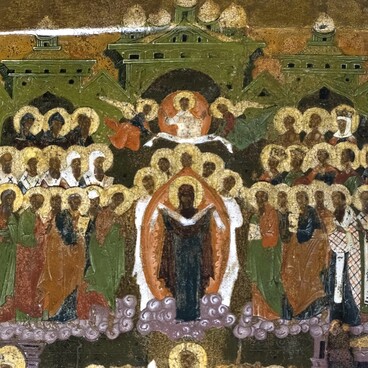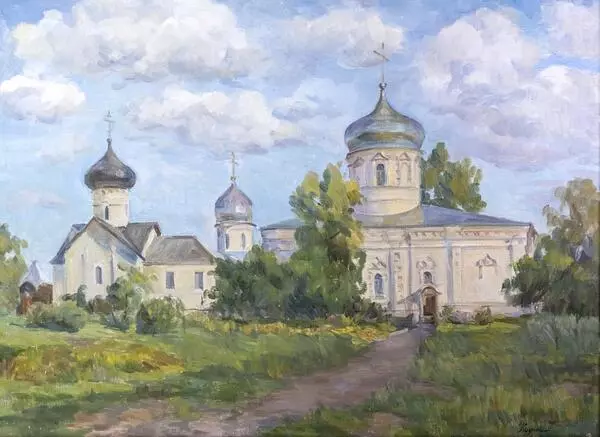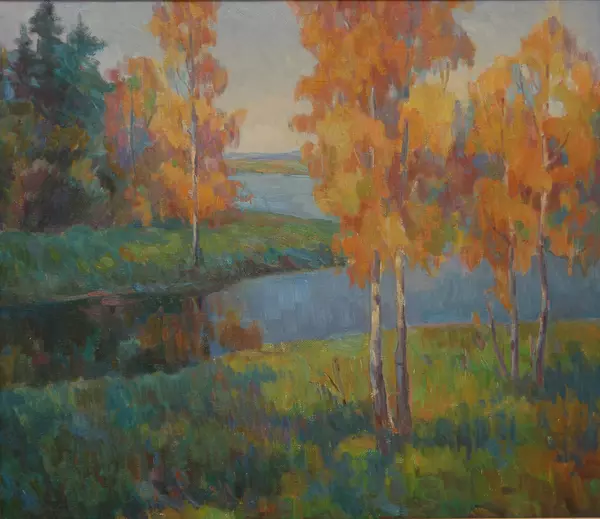The Saint Anthony’s Monastery (Antoniev Monastery) was named after its founder Anthony the Roman. According to his 16th-century hagiography, the noble young man devoted his life to Orthodox Christianity and settled on a rock. On the day of the Nativity of the Blessed Virgin Mary, a storm transported him to the shore of the Volkhov River. There he founded a monastery, and consecrated its first church in honor of this feast.
Historians admit that Anthony could have been a missionary from the Kyiv-Pechersk Lavra. Thus, he enjoyed the support of the authoritative Bishop Nikita (who blessed the construction of the monastery somewhere between 1100 and 1130) and Archbishop Nifont (who appointed Anthony hegumen of the church).
According to the Novgorod First Chronicle, the foundation of the first stone church of the Nativity of the Virgin was laid in 1117. The church was built and consecrated in 1119, and painted in 1125. Saint Anthony died in 1147; the shrine with his relics was kept in the cathedral for a long time.
During the period of the Novgorod Republic, the monastery was the most influential after the St. George’s (Yuriev), Khutyn and Arkazhy monasteries. It owned lands in Shelonskaya, Vodskaya and Derevskaya pyatinas (administrative divisions); in the 14th century it enjoyed the patronage of Archbishop Alexy. The hegumen of the Antoniev Monastery, Sava Kuprov, in 1359 was even nominated for the post of an elected posadnik (mayor), which was unprecedented for a representative of the black clergy (monastic clergy).
The monastery was damaged in the fires of 1378, 1396 and 1467, and was burned twice by the Novgorodians when the troops of Dmitry Donskoy (1386) and Ivan III (1471) approached to the city. Having annexed Novgorod, Ivan III, the Grand Prince of Moscow, confiscated a significant part of the monastery’s property.
In 1533–1536, a refectory with the pillarless Church of the Presentation of the Lord was built there; at the same time, a bell tower with the church of Anthony the Great was erected, from which the brothers were summoned to meal and prayer. In the 16th century, under Hegumen Benjamin, a fragment of a rock with the imprint of Anthony’s foot was obtained and embedded into the wall of the cathedral. The saint was miraculously transported to Novgorod on this rock.
The Swedish invasion in the early 17th century damaged the monastery, but the stone churches of the Presentation and the Nativity of the Virgin, the refectory, the gate church, the bell tower and the rich library of 217 books, including 44 manuscripts written on parchment, survived. The inventory of 1617 mentions the monastery among the four largest.
In the middle of the century, the destitute Nativity Monastery on Krasnoye Pole (1647), Nativity Monastery in Molvotitsy (1675) and St. Nicholas Volokozhkovsky Monastery (1680) became part of the Saint Anthony’s Monastery. In the 18th century, the Antoniev Monastery served as the residence of the Novgorod vicar bishops, the Alexander Nevsky Church with a hospital and other buildings were added, and a seminary was founded.
Many voivodes, boyars and archbishops were buried in the monastery.
Historians admit that Anthony could have been a missionary from the Kyiv-Pechersk Lavra. Thus, he enjoyed the support of the authoritative Bishop Nikita (who blessed the construction of the monastery somewhere between 1100 and 1130) and Archbishop Nifont (who appointed Anthony hegumen of the church).
According to the Novgorod First Chronicle, the foundation of the first stone church of the Nativity of the Virgin was laid in 1117. The church was built and consecrated in 1119, and painted in 1125. Saint Anthony died in 1147; the shrine with his relics was kept in the cathedral for a long time.
During the period of the Novgorod Republic, the monastery was the most influential after the St. George’s (Yuriev), Khutyn and Arkazhy monasteries. It owned lands in Shelonskaya, Vodskaya and Derevskaya pyatinas (administrative divisions); in the 14th century it enjoyed the patronage of Archbishop Alexy. The hegumen of the Antoniev Monastery, Sava Kuprov, in 1359 was even nominated for the post of an elected posadnik (mayor), which was unprecedented for a representative of the black clergy (monastic clergy).
The monastery was damaged in the fires of 1378, 1396 and 1467, and was burned twice by the Novgorodians when the troops of Dmitry Donskoy (1386) and Ivan III (1471) approached to the city. Having annexed Novgorod, Ivan III, the Grand Prince of Moscow, confiscated a significant part of the monastery’s property.
In 1533–1536, a refectory with the pillarless Church of the Presentation of the Lord was built there; at the same time, a bell tower with the church of Anthony the Great was erected, from which the brothers were summoned to meal and prayer. In the 16th century, under Hegumen Benjamin, a fragment of a rock with the imprint of Anthony’s foot was obtained and embedded into the wall of the cathedral. The saint was miraculously transported to Novgorod on this rock.
The Swedish invasion in the early 17th century damaged the monastery, but the stone churches of the Presentation and the Nativity of the Virgin, the refectory, the gate church, the bell tower and the rich library of 217 books, including 44 manuscripts written on parchment, survived. The inventory of 1617 mentions the monastery among the four largest.
In the middle of the century, the destitute Nativity Monastery on Krasnoye Pole (1647), Nativity Monastery in Molvotitsy (1675) and St. Nicholas Volokozhkovsky Monastery (1680) became part of the Saint Anthony’s Monastery. In the 18th century, the Antoniev Monastery served as the residence of the Novgorod vicar bishops, the Alexander Nevsky Church with a hospital and other buildings were added, and a seminary was founded.
Many voivodes, boyars and archbishops were buried in the monastery.






